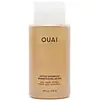Ouai Detox Shampoo Versus Sachajuan Scalp Shampoo
What's inside
What's inside
 Key Ingredients
Key Ingredients

No key ingredients
 Benefits
Benefits

 Concerns
Concerns

 Ingredients Side-by-side
Ingredients Side-by-side

Water
Skin ConditioningSodium C14-16 Olefin Sulfonate
CleansingSodium Lauroyl Methyl Isethionate
CleansingCocamidopropyl Betaine
CleansingDecyl Glucoside
CleansingAcrylates Copolymer
Cocamide Mipa
EmulsifyingParfum
MaskingPolysorbate 20
EmulsifyingHydrolyzed Keratin
HumectantHydroxypropyl Guar Hydroxypropyltrimonium Chloride
Vinegar
PEG-150 Distearate
EmulsifyingPolyquaternium-7
Glycerin
HumectantBenzophenone-4
UV AbsorberSodium Chloride
MaskingSodium Hydroxide
BufferingTetrasodium EDTA
Trisodium Ethylenediamine Disuccinate
Isopropyl Alcohol
SolventPropylene Glycol
HumectantCitric Acid
BufferingDisodium EDTA
Chlorphenesin
AntimicrobialSodium Benzoate
MaskingPhenoxyethanol
PreservativePotassium Sorbate
PreservativeLinalool
PerfumingCitronellol
PerfumingCI 14700
Cosmetic ColorantCI 19140
Cosmetic ColorantCI 61570
Cosmetic ColorantWater, Sodium C14-16 Olefin Sulfonate, Sodium Lauroyl Methyl Isethionate, Cocamidopropyl Betaine, Decyl Glucoside, Acrylates Copolymer, Cocamide Mipa, Parfum, Polysorbate 20, Hydrolyzed Keratin, Hydroxypropyl Guar Hydroxypropyltrimonium Chloride, Vinegar, PEG-150 Distearate, Polyquaternium-7, Glycerin, Benzophenone-4, Sodium Chloride, Sodium Hydroxide, Tetrasodium EDTA, Trisodium Ethylenediamine Disuccinate, Isopropyl Alcohol, Propylene Glycol, Citric Acid, Disodium EDTA, Chlorphenesin, Sodium Benzoate, Phenoxyethanol, Potassium Sorbate, Linalool, Citronellol, CI 14700, CI 19140, CI 61570
Water
Skin ConditioningSodium Laureth Sulfate
CleansingCocamidopropyl Betaine
CleansingSodium Chloride
MaskingPiroctone Olamine
PreservativeClimbazole
AntimicrobialHydrolyzed Wheat Protein
Skin ConditioningC12-13 Alkyl Lactate
EmollientLactic Acid
BufferingButylene Glycol
HumectantZingiber Officinale Root Extract
MaskingSalicylic Acid
MaskingMenthol
MaskingRosmarinus Officinalis Leaf Oil
MaskingPolysorbate 20
EmulsifyingSodium Benzoate
MaskingPotassium Sorbate
PreservativeSorbic Acid
PreservativeWater, Sodium Laureth Sulfate, Cocamidopropyl Betaine, Sodium Chloride, Piroctone Olamine, Climbazole, Hydrolyzed Wheat Protein, C12-13 Alkyl Lactate, Lactic Acid, Butylene Glycol, Zingiber Officinale Root Extract, Salicylic Acid, Menthol, Rosmarinus Officinalis Leaf Oil, Polysorbate 20, Sodium Benzoate, Potassium Sorbate, Sorbic Acid
 Reviews
Reviews

Ingredients Explained
These ingredients are found in both products.
Ingredients higher up in an ingredient list are typically present in a larger amount.
Cocamidopropyl Betaine is a fatty acid created by mixing similar compounds in coconut oil and dimethylaminopropylamine, a compound with two amino groups.
This ingredient is a surfactant and cleanser. It helps gather the dirt, pollutants, and other impurities in your skin to be washed away. It also helps thicken a product and make the texture more creamy.
Being created from coconut oil means Cocamidopropyl Betaine is hydrating for the skin.
While Cocamidopropyl Betaine was believed to be an allergen, a study from 2012 disproved this. It found two compounds in unpure Cocamidopropyl Betaine to be the irritants: aminoamide and 3-dimethylaminopropylamine. High-grade and pure Cocamidopropyl Betaine did not induce allergic reactions during this study.
Learn more about Cocamidopropyl BetainePolysorbate 20 is made by combining ethoxylation of sorbitan, ethylene oxide, and lauric acid. It is a mild cleansing agent, surfactant, and emulsifier.
As a surfactant, it helps collect dirt and oils for washing. Emulsifiers prevent oils and water from separating.
Polysorbate 20 also adds scent to a product. Since it is made using sorbitol, it has a sweet scent. Sorbitol can also be found in fruits such as apples and peaches.
The lauric acid used to create Polysorbate 20 is often derived from coconuts.
Polysorbate 20 may not be fungal acne safe.
Learn more about Polysorbate 20Potassium Sorbate is a preservative used to prevent yeast and mold in products. It is commonly found in both cosmetic and food products.
This ingredient comes from potassium salt derived from sorbic acid. Sorbic acid is a natural antibiotic and effective against fungus.
Both potassium sorbate and sorbic acid can be found in baked goods, cheeses, dried meats, dried fruit, ice cream, pickles, wine, yogurt, and more.
You'll often find this ingredient used with other preservatives.
Learn more about Potassium SorbateSodium Benzoate is a preservative. It's used in both cosmetic and food products to inhibit the growth of mold and bacteria. It is typically produced synthetically.
Both the US FDA and EU Health Committee have approved the use of sodium benzoate. In the US, levels of 0.1% (of the total product) are allowed.
Sodium benzoate works as a preservative by inhibiting the growth of bacteria inside of cells. It prevents the cell from fermenting a type of sugar using an enzyme called phosphofructokinase.
It is the salt of benzoic acid. Foods containing sodium benzoate include soda, salad dressings, condiments, fruit juices, wines, and snack foods.
Studies for using ascorbic acid and sodium benzoate in cosmetics are lacking, especially in skincare routines with multiple steps.
We always recommend speaking with a professional, such as a dermatologist, if you have any concerns.
Learn more about Sodium BenzoateChances are, you eat sodium chloride every day. Sodium Chloride is also known as table salt.
This ingredient has many purposes in skincare: thickener, emulsifier, and exfoliator.
You'll most likely find this ingredient in cleansers where it is used to create a gel-like texture. As an emulsifier, it also prevents ingredients from separating.
There is much debate on whether this ingredient is comedogenic. The short answer - comedogenic ratings don't tell the whole story. Learn more about comegodenic ratings here.
The concensus about this ingredient causing acne seems to be divided. Research is needed to understand if this ingredient does cause acne.
Scrubs may use salt as the primary exfoliating ingredient.
Learn more about Sodium ChlorideWater. It's the most common cosmetic ingredient of all. You'll usually see it at the top of ingredient lists, meaning that it makes up the largest part of the product.
So why is it so popular? Water most often acts as a solvent - this means that it helps dissolve other ingredients into the formulation.
You'll also recognize water as that liquid we all need to stay alive. If you see this, drink a glass of water. Stay hydrated!
Learn more about Water